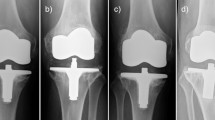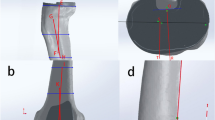Abstract
Purpose
The purpose of this study was to examine the effect of deep flexion on the long-term durability of a high-flex ceramic implant in total knee arthroplasty.
Methods
Five hundred and five consecutive knees replaced with a Bi-Surface knee system (Kyocera Medical, Osaka, Japan) were divided into two groups according to the range of flexion by 135° postoperatively. Comparison of implant durability was made between the high- and low-flexion groups after a minimum ten year follow-up.
Results
With revision for any surgery as the end point, the survival rates at ten years were 95.5 % and 96.2 % in the high- and low-flexion group, respectively (p = 0.63). With revision for mechanical failure as the end point, survival rates were 98.7 % and 98.5 %, respectively (p = 0.94).
Conclusion
Implant survival rate was similar for both groups. Deep flexion seemed not to affect long-term durability.




Similar content being viewed by others
References
Lachiewicz PF, Soileau ES (2009) Fifteen-year survival and osteolysis associated with a modular posterior stabilized knee replacement. A concise follow-up of a previous report. J Bone Joint Surg Am 91(6):1419–1423
Parsch D, Kruger M, Moser MT, Geiger F (2009) Follow-up of 11–16 years after modular fixed-bearing TKA. Int Orthop 33(2):431–435
Rasquinha VJ, Ranawat CS, Cervieri CL, Rodriguez JA (2006) The press-fit condylar modular total knee system with a posterior cruciate-substituting design. A concise follow-up of a previous report. J Bone Joint Surg Am 88(5):1006–1010
Hemmerich A, Brown H, Smith S, Marthandam SS, Wyss UP (2006) Hip, knee, and ankle kinematics of high range of motion activities of daily living. J Orthop Res 24(4):770–781
Mulholland SJ, Wyss UP (2001) Activities of daily living in non-Western cultures: range of motion requirements for hip and knee joint implants. Int J Rehabil Res 24(3):191–198
Nakamura S, Takagi H, Asano T, Nakagawa Y, Kobayashi M, Nakamura T (2010) Fluoroscopic and computed tomographic analysis of knee kinematics during very deep flexion after total knee arthroplasty. J Arthroplasty 25(3):486–491. doi:10.1016/j.arth.2008.12.006
Komistek RD, Kane TR, Mahfouz M, Ochoa JA, Dennis DA (2005) Knee mechanics: a review of past and present techniques to determine in vivo loads. J Biomech 38(2):215–228
Nagura T, Dyrby CO, Alexander EJ, Andriacchi TP (2002) Mechanical loads at the knee joint during deep flexion. J Orthop Res 20(4):881–886
Sharma A, Komistek RD, Scuderi GR, Cates HE Jr (2007) High-flexion TKA designs: what are their in vivo contact mechanics? Clin Orthop Relat Res 464:117–126
Nagura T, Matsumoto H, Kiriyama Y, Chaudhari A, Andriacchi TP (2006) Tibiofemoral joint contact force in deep knee flexion and its consideration in knee osteoarthritis and joint replacement. J Appl Biomech 22(4):305–313
Akagi M, Nakamura T, Matsusue Y, Ueo T, Nishijyo K, Ohnishi E (2000) The Bisurface total knee replacement: a unique design for flexion. Four-to-nine-year follow-up study. J Bone Joint Surg Am 82-A(11):1626–1633
Kim YH, Kim DY, Kim JS (2007) Simultaneous mobile- and fixed-bearing total knee replacement in the same patients. A prospective comparison of mid-term outcomes using a similar design of prosthesis. J Bone Joint Surg Br 89(7):904–910
Nakamura S, Kobayashi M, Ito H, Nakamura K, Ueo T, Nakamura T (2010) The Bi-Surface total knee arthroplasty: minimum 10-year follow-up study. Knee 17(4):274–278. doi:10.1016/j.knee.2010.02.015
Tarabichi S, Tarabichi Y, Hawari M (2010) Achieving deep flexion after primary total knee arthroplasty. J Arthroplasty 25(2):219–224. doi:10.1016/j.arth.2008.11.013
Cho SD, Youm YS, Park KB (2011) Three- to six-year follow-up results after high-flexion total knee arthroplasty: can we allow passive deep knee bending? Knee Surg Sports Traumatol Arthrosc 19(6):899–903. doi:10.1007/s00167-010-1218-x
Han HS, Kang SB, Yoon KS (2007) High incidence of loosening of the femoral component in legacy posterior stabilised-flex total knee replacement. J Bone Joint Surg Br 89(11):1457–1461
Oonishi H, Ueno M, Kim SC, Oonishi H, Iwamoto M, Kyomoto M (2009) Ceramic versus cobalt-chrome femoral components; wear of polyethylene insert in total knee prosthesis. J Arthroplasty 24(3):374–382
Akagi M, Kaneda E, Nakamura T, Ueno M, Yamanashi W, Miyajima H (2002) Functional analysis of the effect of the posterior stabilising cam in two total knee replacements. A comparison of the Insall/Burstein and Bisurface prostheses. J Bone Joint Surg Br 84(4):561–565
Akagi M, Ueo T, Takagi H, Hamanishi C, Nakamura T (2002) A mechanical comparison of 2 posterior-stabilizing designs: Insall/Burstein 2 knee and Bisurface knee. J Arthroplasty 17(5):627–634
Ueo T, Kihara Y, Ikeda N, Kawai J, Nakamura K, Hirokawa S (2011) Deep flexion-oriented bisurface-type knee joint and its tibial rotation that attributes its high performance of flexion. J Arthroplasty 26(3):476–482. doi:10.1016/j.arth.2010.02.011
Insall JN, Dorr LD, Scott RD, Scott WN (1989) Rationale of the Knee Society clinical rating system. Clin Orthop Relat Res 248:13–14
Zelle J, Barink M, De Waal Malefijt M, Verdonschot N (2009) Thigh-calf contact: does it affect the loading of the knee in the high-flexion range? J Biomech 42(5):587–593
Nagura T, Otani T, Suda Y, Matsumoto H, Toyama Y (2005) Is high flexion following total knee arthroplasty safe?: evaluation of knee joint loads in the patients during maximal flexion. J Arthroplasty 20(5):647–651
Sharma A, Leszko F, Komistek RD, Scuderi GR, Cates HE Jr, Liu F (2008) In vivo patellofemoral forces in high flexion total knee arthroplasty. J Biomech 41(3):642–648
Matsuzaki T, Matsumoto T, Muratsu H, Kubo S, Matsushita T, Kawakami Y, Ishida K, Oka S, Kuroda R, Kurosaka M (2013) Kinematic factors affecting postoperative knee flexion after cruciate-retaining total knee arthroplasty. International orthopaedics 37(5):803–808
Kurita M, Tomita T, Yamazaki T, Fujii M, Futai K, Shimizu N, Yoshikawa H, Sugamoto K (2012) In vivo kinematics of high-flex mobile-bearing total knee arthroplasty, with a new postcam design, in deep knee bending motion. Int Orthop 36(12):2465–2471
Nagai K, Muratsu H, Matsumoto T, Maruo A, Miya H, Kuroda R, Kurosaka M (2013) Influence of intra-operative parameters on postoperative early recovery of active knee flexion in posterior-stabilized total knee arthroplasty. Int Orthop 37(11):2153–2157
Vaninbroukx M, Labey L, Innocenti B, Bellemans J (2009) Cementing the femoral component in total knee arthroplasty: which technique is the best? Knee 16(4):265–268
Conflict of interest
None.
Author information
Authors and Affiliations
Corresponding author
Rights and permissions
About this article
Cite this article
Nakamura, S., Ito, H., Kobayashi, M. et al. Are the long term results of a high-flex total knee replacement affected by the range of flexion?. International Orthopaedics (SICOT) 38, 761–766 (2014). https://doi.org/10.1007/s00264-013-2179-8
Received:
Accepted:
Published:
Issue Date:
DOI: https://doi.org/10.1007/s00264-013-2179-8




